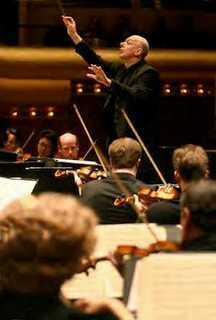|
Back
Death and Botstein’s Resurrections New York
Avery Fisher Hall, Lincoln Center
11/15/2009 -
The Remains of Romanticism
Robert Fuchs: Serenade, Opus 9 (US Premiere)
Siegmund von Hausegger: Wieland der Schmied (Wieland the Blacksmith), Symphonic poem
Hermann Goetz: Concerto for Violin and Orchestra, Opus 22
Ludwig Thuille: Romantic Overture, Opus 16
Richard Strauss: Symphony No. 2 in F minor, Opus 12
Myra Wong (Violin)
American Symphony Orchestra, Leon Botstein (Music Director and Conductor)

L. Botstein and ASO (© Steve J. Sherman)
After 2,000-odd years, the world has found somebody else to resurrect the dead. Leon Botstein and his American Symphony Orchestra habitually resurrect forgotten composers, raising them spiritually, musically and (sometimes) emotionally. Who else but Maestro Botstein could attract an audience to surrender an Indian Summer New York afternoon to hear the likes of Hermann Goetz, Ludwig Thuille, and–most splendid to type on the computer–Siegmund von Hausegger’s Wieland der Schmied?
Yet Mr.Botstein has been doing this for many years. And even if these largely forgotten composers deserve to lie in the earth, he has at least given us the chance to hear why they are gone for good.
Four of this afternoon’s quintet are amongst the most obscure. And listening to the first work, Robert Fuchs’ Serenade, one can see how they could have had their moments (in this case 1874), but are confined to musty history.
Yet hold!! Is it true that Mr. Fuchs (1847-1927) was the teacher of Gustav Mahler and Jean Sibelius? That would be like saying that Norman Mailer and Philip Roth were inspired by Emily Post. For this Serenade is a five-movement trifle, thankfully five short movements of piano salon music wasted on the polished ASO string section. Certainly a fluent composer, ahough the pieces resemble submissions of a young composition student. On the good side, either Brahms or Dvorák could have sewn together three measures from each movement to make a decent Slavonic dance.
Siegmund von Hausegger (1872-1948), who, in his antediluvian years became a good Nazi, tells of a heroic blacksmith who rescues a damsel in distress and then flies above the clouds on gossamer wings. Truth to tell, Siegmund von Hausegger was a pretty dynamic orchestrator, producing a truncated Heldenleben. He starts with a vicious storm, then brings in a love interest with flutes, harps and high violins–actually a very lovely theme. Now comes the war and the drums bounding.
The only real problem with Siegmund von Hausegger is the finale. In the symphonic poem, he is supposed to illustrate the building of wings, allowing for a magical flight into heaven. Now I’m no expert on wing-building or ascents to the cloudy afterlife. But one would imagine (as Berlioz and Gounod did), that these flights would be airy and light. Siegmund von Hausegger, perhaps under the impression that wings were overloaded dirigibles, loaded the ascent with drums, trumpets, winds, strings and all the trappings that would have crashed upon takeoff.
I don’t wish to belittle Mr. Botstein’s efforts, for the last three works had much to recommend. In fact, the short Violin Concerto by the short-lived Hermann Goetz (1840-1876) was an elegant and lovely work, played with suitable elegance by Myra Wong. Best of all I was astonished to learn that Ms. Wong’s Strad was owned by the favorite fiddler of the late 19th Century, Joseph Joachim. While the program has it wrong–Joachim was not a “German” but a Jewish Hungarian–hearing the same sounds which Brahms heard in his own concerto was well worthwhile.
Ludwig Thuille’s (1861-1907) Romantic Oveture was dashing, brilliant, flashy and good fun. But Richard Strauss’s Second Symphony showed exactly why Strauss could not write symphonies. Richard Strauss (1864-1949) was a story-teller, whether in opera or orchestra. Here the material of the first movement was well inspired, but the development was as boring as Strauss must have been bored in writing. The scherzo has no Till Eulenspiegel fun, but the slow movement was charming enough for its time.
(I am hardly convinced by Fred Kirshnit’s note that the movement creates a “pantheistic vision of humanity and its place in the universe.” But the hype was more interesting than the music.)
The finale was second-rate but perfectly proficient Richard Strauss. Three years after this 1884 work, he would find his own voice. And that voice, unlike the other works here, has never had a death and hardly needs Mr. Botstein’s well-meaning resurrections.
Harry Rolnick
|